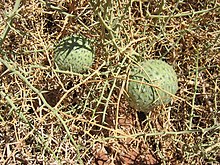Acanthosicyos horridus
| Acanthosicyos horridus | |
|---|---|

| |
| Scientific classification | |
| Kingdom: | Plantae |
| Clade: | Tracheophytes |
| Clade: | Angiosperms |
| Clade: | Eudicots |
| Clade: | Rosids |
| Order: | Cucurbitales |
| Family: | Cucurbitaceae |
| Genus: | Acanthosicyos |
| Species: | A. horridus
|
| Binomial name | |
| Acanthosicyos horridus | |
Acanthosicyos horridus is an unusual
Description
It is a
Ecology
Its sand-binding characteristics also help nara form microclimates within the desert dunes. These microclimates provide food and shelter for a variety of vertebrates.[7] Presence of the nara plant is associated with significantly increased soil microdiversity likely due to the shade it provides and the attraction of foraging mammals which contribute to organic matter.[8]
Acanthosicyos horridus typically occurs in the absence of other vegetation due to the harshness of the climate,
Black-backed jackals sniff out its ripe melon fruits using their jaws to bite through their tough skins. "The chewing molars of canids make them ideal agents for endozoochorous dispersal of large seeds."[10] Such disperal is long-distence (7–15.9 km). The jackals urinate on buried fruits and later return to them; it is suggested either to mark ownership or mask their smell from rival jackals. Seeds from their droppings germinate better than those extracted directly from ripe fruit. Further, seeds from their scats may then be collected by scatter-hoarding gerbils which move them into microhabitats further dispersing them and optimising their germination. While other carnivores eat other fruits, this seems to be the first case where they might be a plant's primary dispersers.[10]
Uses

The melon fruits average 1 kg and are pale green and spiny. Within it has a sweet, aromatic, watery, yellow-orange pulp. The large edible seeds, white to cream in color, are known as butter-nuts or butterpips. These have been exported for use in baked goods.[3][4]
The fruit serves as a food source for Nama people from February to April and August to September.[5]
See also
References
- ^ "Acanthosicyos horridus". International Plant Names Index (IPNI). Royal Botanic Gardens, Kew; Harvard University Herbaria & Libraries; Australian National Botanic Gardens.
- ^ Bentham, G. & Hooker, J.D. (1867) Gen. Pl. 1(3): 824
- ^ a b c Grubben, G.J.H. & Denton, O.A. (2004) Plant Resources of Tropical Africa 2. Vegetables. PROTA Foundation, Wageningen; Backhuys, Leiden; CTA, Wageningen.
- ^ a b c d e "Indigenous plants of Namibia: !nara". Travel News Namibia. 2015-03-24. Archived from the original on 2017-11-04. Retrieved 2017-11-05.
- ^ a b c "Nara Plant, Acanthosicyos horrida, Namibia". Siyabona Africa, Kruger Park Safaris. Archived from the original on 9 June 2011. Retrieved 2011-06-23.
- ^ a b Cornelia Bettina Krug (2002). "Adaptations of the four-striped field mouse (Rhabdomys pumilio, Sparman 1784) to the Namib Desert" (PDF). University of Bonn.
- .
- S2CID 102353767.
- S2CID 85153234. Archived from the originalon 2011-07-22. Retrieved 2009-09-18.
- ^ ISSN 0952-8369.
External links
- PROTAbase on Acanthosicyos horridus
- Dressler, S.; Schmidt, M. & Zizka, G. (2014). "Acanthosicyos horridus". African plants – a Photo Guide. Frankfurt/Main: Forschungsinstitut Senckenberg.
